Posts Tagged ‘Data Projects’
California Ranks 19th in KidsCOUNT Data Book
The 2010 KidsCOUNT Data Book was released today by the Annie E. Casey Foundation. Using 10 key child health indicators, the Data Book ranks states according to how they’ve fared in those measures since 2000 — and also provides national comparisons.
This year, California ranks 19th — a slight improvement over the rank of 20 in the 2009 Data Book. Since 2000, our state has improved in nearly every area featured: infant mortality, child and teen death rates, teen birth rates, and others.
Some areas have seen significant improvements — such as a 40% decrease in the teen birth rate from 2000-2008; and a 20% decrease in the death rate for children ages 0-14.
However, there are two areas that do not show improvement — low birthweights and single-parent families. According to KidsCOUNT, nearly 7% of babies in California were born at a low birthweight — an increase since 2000, but lower than the national average of 8.2%. In 2008, 32% of California children lived in single-parent families, which is an increase of 7% since 2000, but in line with the national average. (According to kidsdata.org, family structure can be an important factor in a child’s physical health and mental health, educational attainment, and poverty status. Studies have shown that single-parent families are more likely than two-parent families to have lower incomes.)
Overall, children’s health in California is improving, according to the 2010 KidsCOUNT Data Book. Our Foundation’s Index of Child and Youth Well-Being also found that child well being improved from 1995 to 2006, but notes that the recent economic downturn threatens those gains.
- To see all the data available for California through the KidsCOUNT data center, visit http://datacenter.kidscount.org/ca.
- Visit kidsdata.org to see data for your community on low birthweight babies, and single-parent families.
Posted by Felicity Simmons
Tags: Data Projects, Data Sources
Could You Live Off of California’s Minimum Wage?
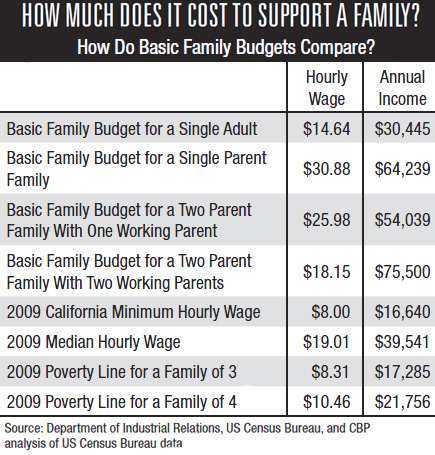 A new report from the California Budget Project brings to light an issue that has a profound effect on the health and well being of children — living off minimum wage in California may be next to impossible.
A new report from the California Budget Project brings to light an issue that has a profound effect on the health and well being of children — living off minimum wage in California may be next to impossible.
According to the report, a single parent family with two children needs an annual income of $64,239 – equivalent to an hourly wage of $30.88 for a 40-hour workweek – to provide the basics: child care, health coverage, food, rent, utilities, transportation, and other modest expenses.
Yet the minimum hourly wage of $8 per hour generates an annual income of $16,640 for a 40-hour workweek – less than half of what’s needed to get by, according to the report. The impact on child well being can be wide-ranging. Children living in poverty are more likely to go hungry, reside in overcrowded or unstable housing, be exposed to violence, and receive a poorer education. Poverty also exposes children to chronic stress, which can hinder their physical, social, and emotional development. Children in families with inadequate income may face more substantial health problems than those in families with enough to meet basic needs.
The report is worth a look. In addition to offering statewide numbers, it includes data for all counties in California.
Posted by kidsdata.org
Tags: Child Health Issues, Data Projects
Children’s Network of Solano County Uses Kidsdata.org in 2010 Report Card
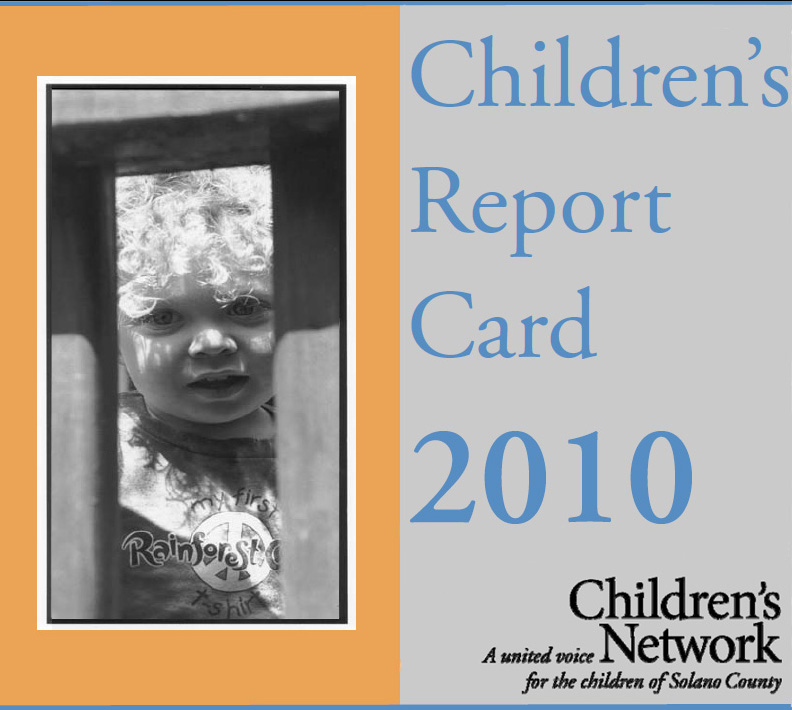 To help the Solano County Board of Supervisors understand and address the needs of the county’s 108,000 children, the Children’s Network of Solano County has published a Children’s Report Card regularly over the past decade.
To help the Solano County Board of Supervisors understand and address the needs of the county’s 108,000 children, the Children’s Network of Solano County has published a Children’s Report Card regularly over the past decade.
The 2010 edition offers a number of recommendations based on data in the report – preserving the basic infrastructure of government services provided to kids; investing more in prevention and early intervention; and involving community-based organizations and advisory councils in planning.
The report also references facts and figures from kidsdata.org numerous times, including data ranging from family economics to emotional, behavioral and physical health.
Since the beginning of the recession, Solano County families have experienced economic hardships in the form of high unemployment, widespread home foreclosures, and dwindling budgets for social programs, as the report notes. A report card helps elected officials and policymakers understand the current impact of these developments and plan for the future.
Solano County’s 2010 Children’s Report Card is a terrific example of how people working on behalf of children can use kidsdata.org. We’d like to thank the Children’s Network of Solano County for using kidsdata.org, and encourage all organizations to reference kidsdata.org in their research, reports, and grants.
Posted by kidsdata.org
Tags: Data Projects, News About Kidsdata.org
Learn About LA’s Communities Using the LA Times New Neighborhood Map
Ever wanted to know more about your neighbors, but were afraid to ask?
Well, the LA Times has asked about your neighbors for you — and mapped out the answers with its neighborhood mapping project.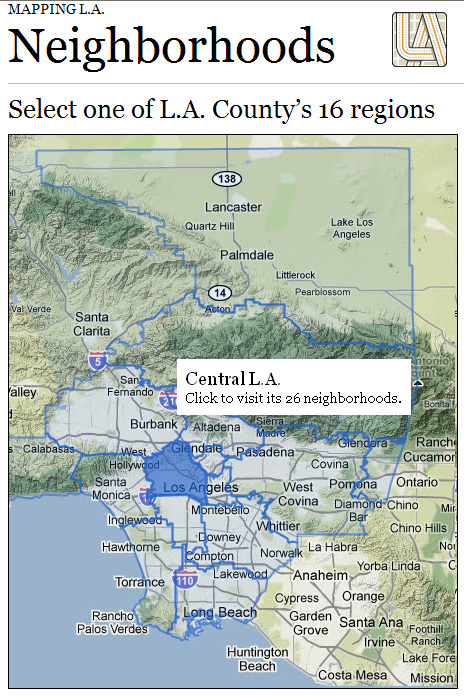
Through a joint effort, the Los Angeles Times and its readers have mapped L.A., providing individual maps and statistics for approximately 158 cities and 114 neighborhoods within the city.
The Times’ neighborhood maps offer information regarding income, education, schools, age, population, and ethnicity, along with up-to-date news from each selected area. You can click on a region to see the neighborhoods available, and then click on any one to view a more detailed map.
As an example, the maps show considerable differences among education levels. In the San Marino neighborhood of the San Gabriel Valley, 70 percent of residents age 25 and older have a four-year college degree, while in the nearby South El Monte neighborhood, that number is a drastically lower 3 percent.
This new mapping tool may well become a valuable resource for Los Angeles-area neighborhoods. Do you know of similar projects statewide where media organizations have mapped their community?
Posted by kidsdata.org
Tags: Data Projects
Our Melting Pot: A California Perspective on the Generational Divide Over Immigration
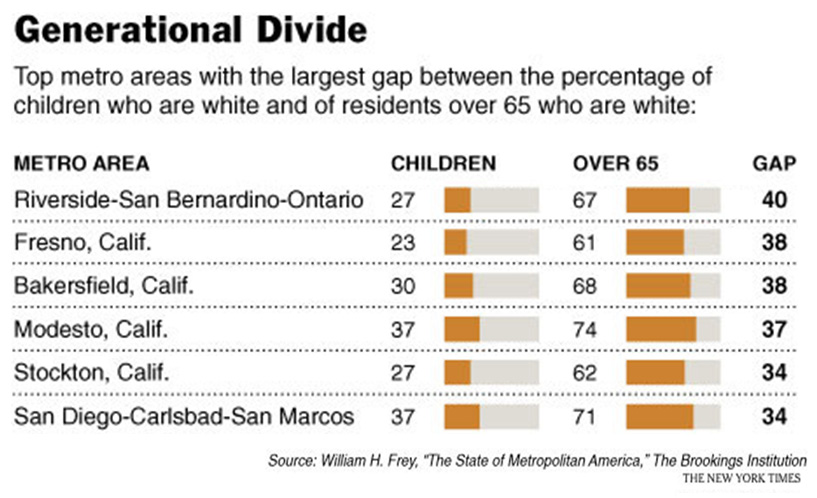 California, it turns out, is diverse even within its diversity, at least judging by newly available immigration data from the Census Bureau’s American Community Survey. In Shasta, Mendocino, Tuolumne, and many other counties, the percent of residents who are foreign born is a tiny fraction of the overall population, adults or kids. But in other counties – Los Angeles, San Francisco, San Mateo, and Santa Clara – nearly half (or more) of residents in some age groups are foreign born.
California, it turns out, is diverse even within its diversity, at least judging by newly available immigration data from the Census Bureau’s American Community Survey. In Shasta, Mendocino, Tuolumne, and many other counties, the percent of residents who are foreign born is a tiny fraction of the overall population, adults or kids. But in other counties – Los Angeles, San Francisco, San Mateo, and Santa Clara – nearly half (or more) of residents in some age groups are foreign born.
Another interesting demographic difference is the generational divide evident in a graphic from the New York Times. California is home to six of the 11 metropolitan areas nationwide that have the largest gap between the percentage of children who are white and of residents over 65 who are white: Riverside-Ontario-San Bernardino, Fresno, Bakersfield, Modesto, Stockton, and San Diego-Carlsbad-San Marcos.
These data are compelling, given survey results that show a generational difference on opinions regarding immigration. A recent New York Times article offers insights as to why younger and older generations differ about their feelings on immigration. The article notes that baby boomers and older Americans “came of age in one of the most homogeneous moments in the country’s history.” In 1970, for example, less than 5 percent of the country was foreign born. By contrast, 13 to 15 percent of the U.S. was foreign born from 1860 through 1920. That percentage – roughly three times the figure in 1970 – is actually quite similar to breakdowns today.
Posted by Andy Krackov
Tags: Data Projects
New Report Projects that Conditions for U.S. Kids Will Worsen
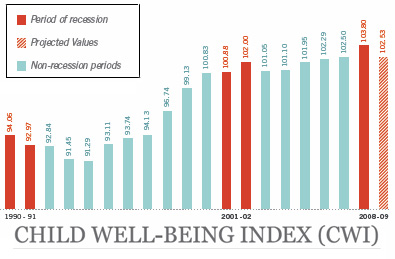 The 2010 Child Well-Being Index (CWI), released this month by the Foundation for Child Development, reveals some startling statistics about how America’s children may be weathering the Great Recession. In 2010, the Great Recession may well wipe out almost all progress made since 1975 for children in the CWI’s Family Economic Well-Being Domain, which brings together measures of children in families living beneath the poverty line, median family income, parental employment, and health insurance coverage. Among the more concerning findings from this year’s
The 2010 Child Well-Being Index (CWI), released this month by the Foundation for Child Development, reveals some startling statistics about how America’s children may be weathering the Great Recession. In 2010, the Great Recession may well wipe out almost all progress made since 1975 for children in the CWI’s Family Economic Well-Being Domain, which brings together measures of children in families living beneath the poverty line, median family income, parental employment, and health insurance coverage. Among the more concerning findings from this year’s
CWI report:
- More than 1 in 5 kids currently live in poverty, according to projections, an increase of 5 percent in only 4 years. A related analysis, issued by our foundation, shows that poverty rates in California may be increasing by even greater amounts.
- Risky behavior, including violent crime and illegal drug use, are anticipated to increase.
- Reliance on cheap food with low nutrition may worsen the child obesity epidemic.
Also, although many measures point to a slowly recovering economy, the CWI shows a lag between when a recession first hits and its eventual impact, which means deteriorating conditions for children through the end of this year – or longer.
The researchers at Duke University who prepared this report also developed a similar index for California that projected that the Great Recession would leave a long-lasting impact on children in the form of sustained high levels of poverty. This California Index of Child and Youth Well Being, commissioned by the Lucile Packard Foundation for Children’s Health, employs measures from kidsdata.org to help illuminate how kids have been faring over time for California and two of the state’s most populous regions, Los Angeles County and the Bay Area.
Posted by Andy Krackov
Tags: Child Health Issues, Data Projects
How Are Kids Faring in CA’s 2nd Biggest County?
The Children’s Initiative recently released the 2009 edition of the San Diego County Report Card on Children and Families, a summary of the overall health and well being of children, youth, and families in the state’s 2nd biggest county, as measured by child population.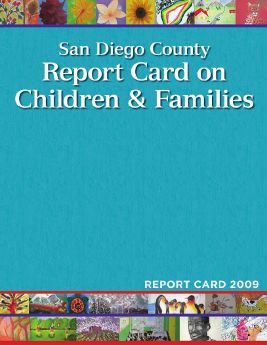
Among the highlights from the report: Although San Diego County child poverty rates are lower than both state and national averages, the rate increased to 16.6 percent of children in 2008 – the highest in the county since 2000.
Some other notable trends from the report include:
- 93 percent of families reported having health care coverage for their children, on par with state averages and well above national averages.
- Domestic violence and child abuse trends are improving, but county rates still remain above the state average. Also, child victims of violent crime have dropped only slightly.
- Despite annual fluctuations, motor vehicle crashes involving DUIs among drivers ages 16-20 are still at the same level as they were in 1996. And DUI arrests among adolescents in this non-legal drinking age group actually are increasing.
The 2009 Report Card also offered 10 recommendations focused on prevention and intervention, including:
- Intensive home visiting of vulnerable families to improve parenting skills and reduce child abuse, neglect, and repeat teen births.
- Closely monitoring school attendance; providing after school programs to help prevent substance abuse; and restoring driver education in schools to reduce DUI cases.
- Improving parent-to-teen communication. Teens reporting good relationships with parents are less likely to engage in truancy, substance abuse, DUI, and crime, the report notes.
- Raising the economic status of poverty-stricken families through health and housing benefits, as well as job training and educational opportunities.
Kidsdata.org has long been affiliated with children’s reports, particularly those in San Mateo and Santa Clara counties, so we know how vital such reports can be in drawing local attention to how kids are faring, and focusing the community on related improvements. If you’re at work on – or recently have released – a summary report on local children, please let us know by adding a comment/link below.
Posted by kidsdata.org
Tags: Data Projects
Reading Report Puts California Data in Perspective
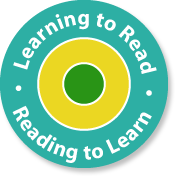 A report released this week by the Annie E. Casey Foundation highlights the percentage of students nationwide who miss the mark in terms of 3rd grade reading proficiency — and what should be done about it.
A report released this week by the Annie E. Casey Foundation highlights the percentage of students nationwide who miss the mark in terms of 3rd grade reading proficiency — and what should be done about it.
The report, “Early Warning! Why Reading by the End of Third Grade Matters,” notes that 33% of 4th graders nationwide scored below “basic” on the 2009 National Assessment of Educational Progress (NAEP) reading test. The percentage scoring below basic was even higher — 49% — among low-income students, and higher still for African American, Hispanic, and American Indian students.
In comparison to other states, California 4th graders ranked close to the top; but no state reached “proficient” status, according to the 2007 NAEP scale.
The Annie E. Casey Foundation offers several recommendations for tackling this issue, including increased family/caregiver involvement, more help for low-performing schools, solutions for chronic school absences and summer learning loss, and early education coordination from birth through 3rd grade. But most of all, the foundation asks public officials to honor the bipartisan work that has already been done in this area with regard to national standards of excellence.
To download the report, visit http://datacenter.kidscount.org/reports/readingmatters.aspx. For local reading proficiency data on kidsdata.org (statewide data coming soon!) visit http://www.kidsdata.org/data/topic/dashboard.aspx?cat=25.
Posted by Felicity Simmons
Tags: Data Projects, Data Sources
Think YOU Can Balance Our State’s Budget?
Today, Gov. Schwarzenegger released his revised budget proposal. Don’t like the proposed cuts? Now you can balance the budget yourself.
The SF Chronicle recently featured the California Budget Challenge, an online game that allows users to attempt to balance the state’s $85 billion budget. Are you hoping California will allocate more funding for kids and families? More money for schools, parks, or health programs? Here’s your chance to spend as you please, but be wary – the Challenge also asks you to decide how you would pay for your dream version of the state budget.
The Challenge, created by the nonpartisan organization Next 10, allows users to build a state budget based on individual “values and vision,” but it also serves to educate voters about the numerous policy choices our legislators must make. For each major budget decision (prison cuts, increases in per pupil spending, gas taxes, etc.), the Challenge offers background information, as well as the arguments for and against each cut or expenditure. After each decision you make, you also can see how fellow Californians chose from the many budget options. Next 10 also offers several other resources to educate the public about the budget process in California, such as the handy 7 facts about the state budget.
To access the California Budget Challenge and other resources, visit their website at http://www.next10.org/next10/programs/budget_challenge.html#.
Posted by Jordan Handcox
Tags: Child Health Initiatives, Data Projects
Kidsdata.org Partners with New Public Policy Site, HealthyCal.org
 Kidsdata.org is pleased to announce a partnership with the recently launched HealthyCal.org — a site that tracks health policy at the state and community level to highlight issues affecting Californians. The site features updates on legislation, and posts on issues from key state leaders and advocates. And — full disclosure — a weekly data posting from kidsdata.org that focuses on an important issue affecting children’s health in California.
Kidsdata.org is pleased to announce a partnership with the recently launched HealthyCal.org — a site that tracks health policy at the state and community level to highlight issues affecting Californians. The site features updates on legislation, and posts on issues from key state leaders and advocates. And — full disclosure — a weekly data posting from kidsdata.org that focuses on an important issue affecting children’s health in California.
Veteran journalist Daniel Weintraub, formerly the public affairs columnist for the editorial pages of the Sacramento Bee, is editor-in-chief of HealthyCal.org, which has received initial funding from The California Endowment. Kudos to Dan for this pioneering effort in the world of healthy policy blogging — we’re glad to be a part of it. Take a look: www.healthycal.org
Posted by Felicity Simmons
Tags: Child Health Initiatives, Data Projects


